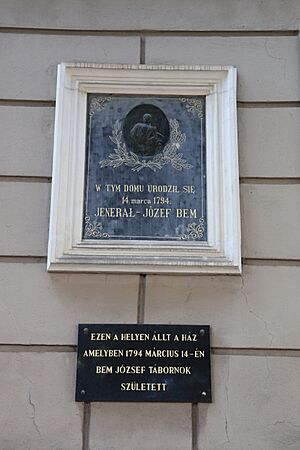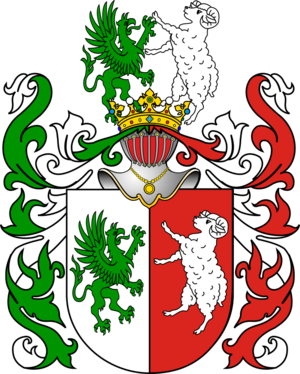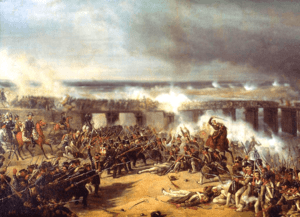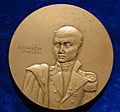Józef Bem facts for kids
Quick facts for kids
Józef Zachariasz Bem
Bem József |
|
|---|---|
 |
|
| Born | March 14, 1794 Tarnów, Kingdom of Galicia and Lodomeria (now Poland) |
| Died | December 10, 1850 (aged 56) Aleppo, Ottoman Empire (now Syria) |
| Buried |
Tarnów (since 1929)
|
| Allegiance | Polish insurgents Revolutionary Hungarian Army Ottoman Army |
| Rank | General |
| Unit | Artillery |
| Battles | Battle of Borodino (1812) Battle of Iganie (1831) Battle of Ostrołęka (1831) Battle of Temesvár (1849) Battle of Segesvár (1849) |
| Awards | |
Józef Zachariasz Bem (Hungarian: Bem József, Turkish: Murat Pasha; March 14, 1794 – December 10, 1850) was a Polish engineer and a brave general. He later became an Ottoman pasha, which was a high military rank. He is a national hero in both Poland and Hungary.
Like other famous Polish heroes such as Tadeusz Kościuszko and Jan Henryk Dąbrowski, Bem fought for freedom and justice far from his home country. He used his amazing leadership and military skills wherever they were needed across Europe.
Contents
Early Life and Education

Józef Bem was born on March 14, 1794, in Tarnów, a city in a part of Poland called Galicia. At that time, this area was controlled by the Habsburg monarchy.
When he was fifteen, he moved to Kraków with his family. He went to a military school there and was very good at mathematics.
Bem joined the Polish army as a young officer. He fought with the French army during their invasion of Russia in 1812. He showed great courage defending the city of Danzig in 1813. For his bravery, he received the Knight's Cross of the Legion d'honneur, a very important French award.
After 1815, Poland became a kingdom linked to the Russian Empire. Bem became a teacher at a military college. He also studied new types of rocket-like missiles and published his findings.
Later, Bem joined a secret group that wanted Poland to be fully independent. When the group was discovered, he was sentenced to prison. Even though he didn't go to prison, he left the army. He then moved to Galicia and studied steam engines.
Fighting for Polish Freedom
In November 1830, a big fight for Polish independence, called the November Uprising, began against the Russian Empire. Józef Bem quickly joined the Polish fighters.
He became a major and led a cavalry group. He fought bravely in important battles like Iganie and Ostrołęka. At Ostrołęka, his actions helped save the Polish army from being completely destroyed, even though they lost many soldiers.
For his courage, Bem was given the Virtuti Militari Golden Cross and became a general. He continued to fight until the very end of the uprising. However, the Polish army eventually had to surrender in October 1831.
Life in Exile
After the uprising ended, Bem went to Paris, France. He taught mathematics to support himself. In Paris, he wrote a book about the Polish uprising. In his book, he shared his thoughts on what went wrong and how the fight for freedom could continue.
In 1833, he traveled to Portugal. He hoped to help a liberal leader there, but he couldn't form a Polish fighting group. During his time in Portugal, Russian agents even tried to assassinate him.
Hero of 1848

In 1848, many revolutions happened across Europe, including in the Austrian Empire. Bem saw a new chance to fight for freedom. He first tried to defend Vienna against the emperor's troops.
After Vienna fell, he went to Bratislava (then called Pressburg). He offered his help to Lajos Kossuth, a leader of the Hungarian Revolution of 1848. Bem was put in charge of defending Transylvania, a region in Hungary.
In 1849, as a general leading the Székely troops, he achieved amazing victories with his small army. One famous battle was at the bridge of Simeria on February 9, where he pushed back a huge enemy force.
After securing Transylvania, he was sent to fight the Austrian General Anton Freiherr von Puchner. Bem defeated von Puchner in May. But then, the Russian army invaded, forcing Bem to retreat.
From July 12 to 22, Bem fought constantly. On July 31, 1849, his army was defeated in the Battle of Segesvár by a much larger force. Bem managed to escape by pretending to be dead. He continued to fight and brought his remaining soldiers to the Battle of Temesvár on August 9. He was badly wounded in this last major battle of the war.
Later Life and Death
After the Hungarian rebellion failed, Bem fled to the Ottoman Empire. There, he became a Muslim and served as the Governor of Aleppo under the name Murad Pasha. His last military success was defeating Bedouin tribes who were attacking Aleppo. He died of malaria on December 10, 1850.
Burial and Mausoleum
Józef Bem was first buried in a military cemetery in Aleppo. In 1926, a group decided to bring his body back to Poland. His special mausoleum was built on an island in a pond in Strzelecki Park in Tarnów.
Since Bem had become a Muslim, he could not be buried in a Catholic cemetery. So, his mausoleum was designed to be above ground. It is a rectangular stone coffin resting on six columns.
On the mausoleum, you can read "Józef Bem" in Polish. In Hungarian, it says "Grandpa Bem, greatest leader of the Hungarian fight for freedom 1848–1849." In Arabic, it says "Lt. General Murat Pasha." The years 1794, 1850, and 1929 are also there, marking his birth, death, and reburial.
His body was brought back to Poland in June 1929. Before reaching Tarnów, his coffin was displayed in museums in Budapest and Kraków. The funeral ceremony in Tarnów took place on June 30, 1929. His coffin was then lifted by cranes and placed inside the mausoleum.
Character and Legacy
Józef Bem was known for his incredible courage and heroic spirit, even though he was not a tall man. People said he had a strong, inspiring presence. Even his Hungarian soldiers, who didn't understand his language, greatly admired him.
As a soldier, Bem was excellent at using artillery and moving his troops very quickly. In Hungary, people lovingly call him "Bem apó", which means "Grandpa Bem" or "Old man Bem."
In the 1930s, both Hungary and Poland named military groups after him. A statue honoring him stands in Târgu Mureș, Romania. He is also remembered in the poems of the famous Hungarian poet Sándor Petőfi, who died in the Battle of Segesvár where Bem also fought.
The Hungarian Revolution of 1956 began on October 23 with a protest at the foot of Bem's statue in Budapest. This shows how important he remains to the people of Hungary.
Works
Józef Bem wrote books in French, Polish, and German about Polish history, technology, and military topics. Some of his works include:
- "Practical Knowledge of Incendiary Rockets" (1820)
- "About Steam Engines" (1829)
- "About National Uprising"
Honors
- Hungary issued three postage stamps in his honor on December 10, 1950, for the 100th anniversary of his death.
- Poland also issued a commemorative postage stamp for him on July 15, 1948, and another on December 10, 1950.
Gallery
-
Statue of Józef Bem in Budapest
-
Commemorative plaque, Cluj-Napoca
-
Monument dedicated to Bem, Târgu Mureș
-
Commemorative plaque, Brasov
-
Bust of Józef Bem at the Józef Bem Square (Polish: Plac Bema) in Ostrołęka
-
Statue in central Tarnów
-
Bem Monument in Warsaw
See also
 In Spanish: Józef Bem para niños
In Spanish: Józef Bem para niños
- History of Poland
- Poland-Hungary relations

















